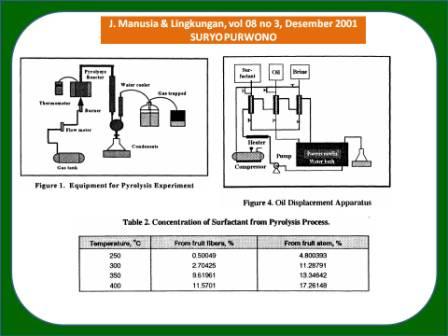
PIROLISIS LIGNIN DARI LIMBAH INDUSTRI KELAPA SAWIT UNTUK PENGEMBANGAN SURFAKTAN DALAM PROSES ENHANCE OIL RECOVERY (EOR) (Pyrolysis of Lignin From Waste of Palm Oil Industries for The Development of Surfactants for Enhance Oil Recovery (EOR))
Suryo Purwono(1*)
(1) Department of Chemical Engineering, Faculty of Engineering, Gadjah Mada University, Yogyakarta, Indonesia
(*) Corresponding Author
Abstract
ABSTRAK
Pirolisis dari lignin yang berasal dari limbah industri kelapa sawit dapat menghasilkan alkohol dan derivatif lainnyd yang dapat digunakan sehagai surfaktan. Prosedur penelitian proses pirolisis ini odalah sebagai berikut: I) serabut atau tandan sisa pengolahon kelapa sawit yang sudah dikeringkan dimasukkan kedalam reaktor dengan berat tertentu dan dipanaskan sampai suhu yang diinginkan, 2) produk pirolisis yang keluar dari reoktor kemudian didinginkan sampoi mencapai suhu kamor, 3) hasil cair ditampung didalam gelas ukur dan hasil gasnya ditampung di suatu botol tertentu. Suhu paling baik yang dicapai adalah 4A0 "C untuk lignin yong berasal dari serabut dan 350'C untuk lignin yang berasal dari tandan kelapa sawit. Surfaktan yang dihasilkan sekitar j4 sampai 38% dari produk pirolisis. Pada penelitian ini kecepatan reaksi dianggap order satu. Hasil penelitian menunjukkan bahwa surfakton yang dihasilkan dapat membentuk emulsi dengan minyak menta.h. Hal ini menunjukkon bahwa surfaktan yang dihasilkan dapat digunakan sebagai bahan untuk proses EOR.
ABSTRACT
Pyrolysis of lignin from waste of palm oil industries produces alcohol and its derivatives which can be sulfonated to become surfactant. The experimental procedures for the pyrolysis process were as follows: 1) dried palm oil husks at a certain weight were put into the pyrolysis reactor and heated up to a certain temperafure; 2) the product leaving the reactor was cooled down to room temperature; and 3) the liquid product was collected in a flask while the gas product was put into a big bottle. The best temperature obtained for producing liquid product was 400 oC for lignin from palm oil fruit fibers and 350 oC for lignin from palm oil fruit stems. The surfactant developed was in the range between 34 and 38% from the pyrolysis product. In this experiment, the reaction rate was assumed to be in first order. The result showed that the surfactant obtained from the experiment could form emulsion with crude oil. This suggests that the surfactant developed can be used for EOR process.
Full Text:
Artikel lengkap (PDF) (Bahasa Indonesia)Article Metrics
Refbacks
- There are currently no refbacks.
Copyright (c) 2017 Jurnal Manusia dan Lingkungan







